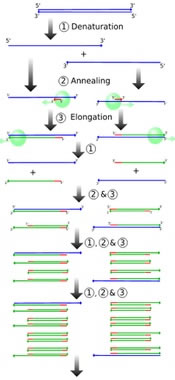
 Untitled Document
Untitled Document
The Polymerase Chain Reaction (PCR)
 |
The vast majority of molecular markers rely on the use of PCR (Mullis et al. 1986).
This process mimics the natural way in which the cell replicates its DNA. It provides a quick, inexpensive way of making a large number (millions) of copies of a specific DNA segment.
A sample of DNA (the "template") is mixed with DNA polymerase and short targeted priming sequences ("primers") (see next slide); then, cycling through various temperatures leads to the production of a copy of the part of the template DNA sequence between the two primers. Reiterating the cycle many times allows the new copies to serve as templates in the next round, resulting in an exponential increase in copy number of the target sequence.
|
Image from Wikipedia, the free encyclopedia











